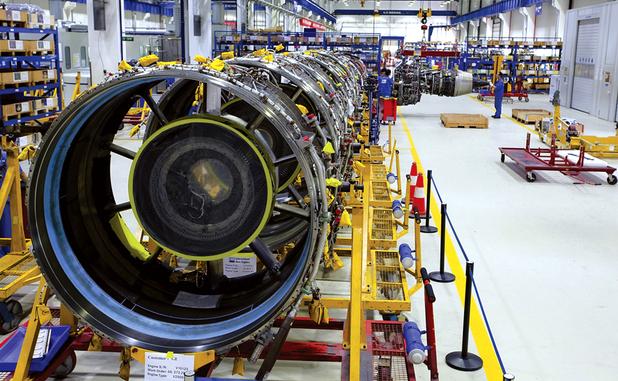
While engine suppliers Safran and MTU Aero Engines posted expected drops in aftermarket revenues for the last quarter, executives from each company highlighted several trends that support a cautiously optimistic outlook for the engine-overhaul market.
Safran’s civil engine aftermarket business was down 56.2% in the 2020 third quarter (Q3), the company said Oct. 30. The drop was a 10-point improvement over the second-quarter (Q2) decline, and “somehow not as [much] as we expected,” CEO Philippe Petitcolin said. “The improvement ... is coming mainly from services and widebody engines, especially the GE90, which is doing a lot better because GE90 is flying a lot more than what we were expecting,” he explained.
Shop-visit volume is down about 50%, which the company expected. But workscopes have been largely unaffected, bolstering the per-overhaul spare-parts sales figures.
“We didn’t see a reduction of value per-shop visit,” Petitcolin said. “There is a small reduction in some of them, but it’s not really material.”
Safran expects the halving of shop-visit volume to continue into 2021 unless CFM International CFM56 flying—primarily the Boeing 737 Next Generation and Airbus A320ceo families—picks up significantly. After a steady increase in Q2, “the improvement in flight cycles has been modest,” the CEO said.
By contrast CFM LEAP-powered aircraft are slowly becoming busier—a reflection of airlines with a choice using their more efficient narrowbody aircraft. The downside for Safran and other CFM56 MRO providers is the LEAPS are younger and further away from lucrative initial shop visits than many CFM56s. Safran and GE Aviation are 50-50 partners in CFM.
MTU said its Q3 bottom line was helped by “slightly higher demand” compared to Q2 for IAE V2500 spare parts from A320ceo operators that use the engine.
“Is that a complete turnaround? No, definitely not. It’s a very cautious recovery, I would say,” MTU CFO Peter Kameritsch said. “It’s only a small effect. We expect, indeed, a little bit more to come in Q4.”
MTU also saw slight improvements in older Pratt & Whitney platforms it services, including the PW2000 and PW4000, primarily due to freighter operators flying more.
“They do send more engines compared to pre-COVID levels,” Kameritsch said. “That is not deferred maintenance, but really a higher utilization of the freighter fleet.”
MTU saw third-quarter commercial aftermarket revenues fall only 6%. Much of the market-driven dropoff was offset by warranty work on PW1100-series engines that helped the company keep its shops busy and revenue coming in.
Like the rest of the MRO business, both companies are hampered by a lack of visibility on what customers are doing. New lockdowns in Europe, rising COVID-19 cases in other key markets including the U.S. and general uncertainly about how the pandemic will progress are forcing airlines to make quick decisions.
“Of the customers that we would normally have at this period of time locked in for the winter maintenance, some are still making critical decisions,” David Doherty, head of sales for Etihad Engineering, told Aviation Week MRO Transatlantic participants Oct. 29. “Instead of sitting and having a conversation about a multi-year maintenance contract, we’re talking about if they are bringing an aircraft in during the next three weeks. Quite often, they’re booking a slot ... but they’re waiting on a board decision on whether that fleet type is actually going to feature in their plans in the next 12 months.”
